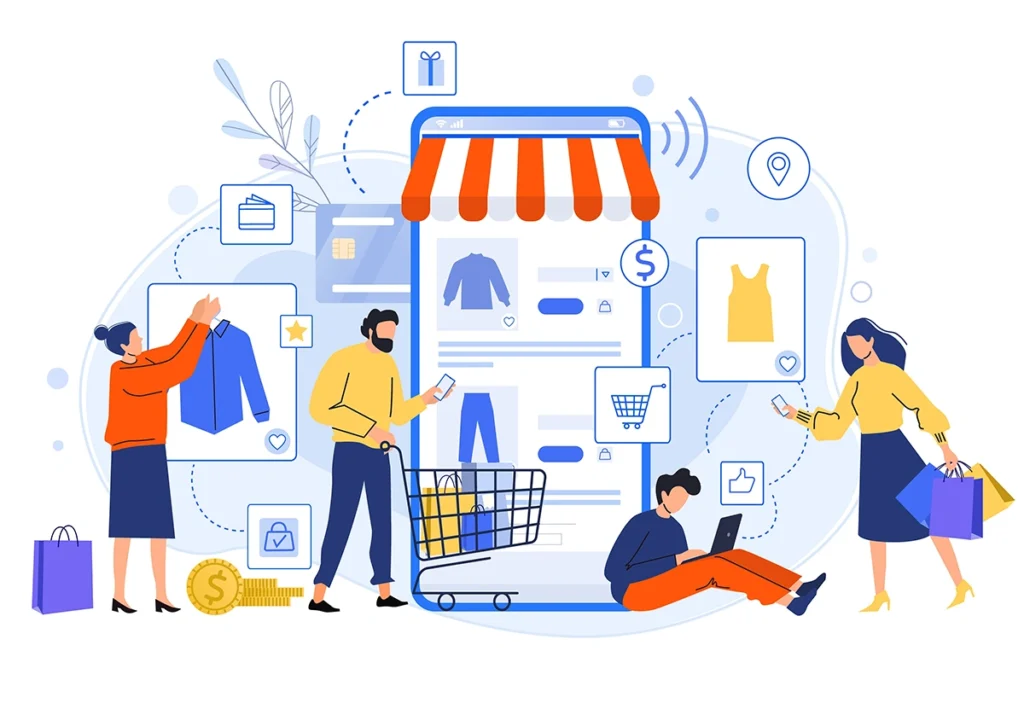Ecommerce SEO is an ongoing process that focuses on boosting the rankings of an online shop in organic search results. In the competitive world of online retail, standing out from the crowd is essential for long-term success.
At its core, ecommerce SEO is about ensuring your online store is fully optimized for both search engines and shoppers. This means the impact of an effective strategy goes far beyond rankings alone. Below, we share proven ecommerce SEO best practices that have consistently boosted visibility, traffic, and sales for West County Net clients.
Optimizing for the Customer’s Journey

Creating a successful ecommerce strategy starts with understanding the buyer’s journey. The path a potential customer takes when making purchasing decisions is the blueprint to an effective SEO strategy for online retailers.
When you align your content with each stage of this journey, you can boost your rankings in search while also guiding shoppers toward confident buying decisions.
Put yourself in your customer’s shoes and consider what they are hoping to accomplish. Are they looking to learn, compare, or buy? Below, we break down the key stages of the buyer’s journey and the types of content that best support each one:
Learn (Awareness Stage)
At this point, people are just starting their buyer’s journey, so they are searching for general information or for answers to common questions. This is your opportunity to build trust. Your goal here is visibility and credibility, not conversion.
For online stores, this means creating content that is genuinely useful to customers, like informational blog posts, guides, and FAQs.
When visitors find useful information on your site that directly addresses their needs and answers their questions, it positions your brand as knowledgeable and trustworthy. Providing the right information at the right time is key to attracting potential customers and guiding them through the sales funnel towards a purchase.
Compare (Consideration Stage)
Now your shopper is narrowing down their options, researching, and comparing products before making a purchase. This is the time to demonstrate real expertise and a genuine understanding of what matters to your customers.
Think in-depth product descriptions, comparison tools, and category pages. Prioritize high-quality images, user-generated content, and even behind-the-scenes content that shows how your products are made or tested.
The goal here is to help a potential customer feel like they’re making a smart, informed purchase. Show them your brand isn’t just trying to make a quick buck, but a team that cares about their customers and stands behind the quality and value of every item you sell.
Buy (Decision Stage)
Your shopper knows what they want now, and they’re ready to make a purchase. Your product pages should do the heavy lifting here.
Use persuasive, value-driven product descriptions that speak directly to customer pain points and needs. Incorporating customer reviews provides social proof, and high-quality images with zoom features and 360° views can also help reduce any uncertainty. And always include a prominent and compelling call to action that makes it easy for people to buy.
Every detail on the page should reinforce trust, reduce friction, and make clicking “Add to Cart” feel like the obvious next step.
By aligning your SEO strategy with how customers find, compare, and purchase products, you ensure your website supports conversions at every stage of their journey.
Product Page Optimization

Your product pages are where conversions happen, so optimizing them is crucial for both SEO and revenue. A well-structured product page not only helps you rank higher in search engines but also provides the info and trust signals that naturally encourage shoppers to buy.
Every element on the page should be designed to engage users, answer their questions, and ultimately guide them towards purchasing. Below are the key areas to focus on when optimizing your product pages:
Title Tags and Meta Descriptions
The title tag and meta description of your products are the first things a shopper sees in search results. They offer a first impression of what you have to offer, so naturally, they have a major impact on traffic to your website and click-through rates (CTR).
Title tags and meta descriptions also provide key information that helps search engines understand the content of a page and rank it for relevant search queries.
- Title Tags: A well-written product title should be both concise and specific to the item. Put the most important details first and include keywords that your ideal customer is likely using.
- Meta Descriptions: Provide a short summary that highlights the value or appeal of the product. Including descriptive terms that are unique to the product, like “waterproof” or “maternity,” can also help attract people who are searching for a product to suit their specific needs.
These elements play a key role in how your products appear in search results and can significantly influence whether a person visits your online store.
Product Descriptions
Product descriptions should do more than just explain an item—they need to sell it. This content serves as your opportunity to showcase what makes your product valuable and the best option to potential customers.
Instead of relying on generic content, prioritize original, benefit-driven language that reflects your unique brand voice. Formatting your text with paragraph breaks and things like bullet points can also make it more user-friendly and easier to read.
Customer Reviews
According to surveys, over 99% of consumers read reviews when they shop online.1 Including features like customer reviews and star ratings on your product pages provides social proof and builds trust with potential buyers.
Seeing genuine feedback from other customers validates the product’s quality and value, helping shoppers feel more confident in their purchase decisions.
Image Quality and Alt Text
Clear, high-resolution images grab the attention of online shoppers and create a positive first impression of both the product and your brand. High-quality images allow customers to see important details and features that aid in their purchasing decisions and help combat dissatisfaction and returns.
Engaging and clear images also encourage longer browsing times, signaling a positive user experience to search engines which helps with rankings. Plus, optimizing your product images with descriptive filenames and alt text boosts visibility in image searches, driving additional organic traffic to your product pages.
User Experience (UX) Optimization

User experience (UX) and SEO are deeply intertwined, especially for ecommerce sites. Optimizing your website to ensure easy navigation, fast load times, and seamless usability across all devices not only improves rankings but also drives higher conversion rates.
Below are the key areas to focus on when optimizing your online store with a positive user experience in mind:
Site Navigation and Architecture
Logical categories, clear internal linking, and user-friendly menus and navigation ensure visitors can find what they need quickly and easily. It also encourages users to browse more pages and spend more time on your site, sending positive user experience signals to search engines.
Plus, a well-structured website also makes it easier for search engines to crawl and index content more efficiently, aiding in rankings.
Responsive Design
With almost 60% of all online shopping now happening on mobile devices2, having a responsive website design is no longer optional. Responsive design means your website seamlessly adapts to different size screens and functions across devices, including smartphones, tablets, and computers.
Any website that isn’t mobile-friendly in 2025 isn’t likely to rank in search at all. Responsive design ensures an enjoyable experience no matter what devices a user is on, which is essential for your online visibility and conversions.
Simple Checkout
A complicated or frustrating checkout process is going to severely impact your conversion rates. If users are consistently dropping off at the final stage of purchase, it may indicate a problem with your site’s usability.
A streamlined checkout experience leads to more completed purchases and can even encourage repeat customers, which ultimately drives revenue. For online retailers, this means ensuring your checkout process is secure, easy, and fast by reducing the steps needed to complete a purchase.
Technical Optimization

Technical optimization ensures your site can be easily crawled, indexed, and ranked. It’s the behind-the-scenes work that helps search engines understand your website, which ultimately helps boost your rankings.
Here are the key technical SEO factors to optimize on an ecommerce site:
Site Speed
In the fast-paced online shopping world, slow loading times can ruin SEO rankings and impact revenue overall. Search engines prioritize websites that offer a smooth and quick user experience. Google has even stated that page speed is a ranking factor on both mobile search and desktop.3
Slow sites often experience lower dwell times and higher bounce rates. This means users don’t spend very much time on the page and leave without engaging with any content or visiting other pages. These negative user signals can significantly harm your rankings.
For ecommerce sites, optimizing for speed is essential to search engine visibility and to avoid losing potential customers.
Secure HTTPS
For any website that processes sensitive user information, especially payment details in an ecommerce context, HTTPS (Hypertext Transfer Protocol Secure) encryption is non-negotiable.
HTTPS encrypts the communication between the user’s browser and the website’s server, signifying that their data is protected from interception. Websites without it are flagged as “not secure” in browsers.
For ecommerce websites, this can severely damage credibility, deter customers from making purchases, and potentially lead to lower search rankings.
XML Sitemaps
XML sitemaps act as a roadmap for search engines. This file makes it easier for the most important pages on your ecommerce site to be crawled, indexed, and ranked. This is particularly crucial for large online shops with lots of product pages, categories, and filters.
While a sitemap doesn’t guarantee rankings, it significantly improves the chances of your product pages being found and included in search results. For new products or website updates, a sitemap can also help expedite the indexing process and get your offerings in front of potential customers faster.
Structured Data (Schema Markup)
Structured data, like schema markup, is code that gives search engines more context about the content of your website. For ecommerce sites, structured data helps search engines understand the specifics of your products, which can boost visibility in search results, rich snippets, and knowledge panels.
Grow Your Ecommerce Business This Year and Beyond

Online retailers today need more than just a website to succeed. A dynamic ecommerce SEO strategy is essential for any business looking to maintain visibility in search, attract more qualified traffic, and ultimately drive more sales.
Don’t leave potential revenue on the table. Take the first step towards unlocking your online store’s full potential by contacting our ecommerce SEO specialists today. Fill out the form below to request your free SEO audit and learn where your biggest growth opportunities lie.
"*" indicates required fields
References
- Team, P. (2024, March 22). The Complete Guide to Ratings & Reviews (2024 Edition). PowerReviews. https://www.powerreviews.com/the-complete-guide-to-ratings-reviews-2024-edition/
- Commerce, S. (2025, February 19). Top 12 Mobile Commerce Statistics of 2025 – SellersCommerce. SellersCommerce. https://www.sellerscommerce.com/blog/mobile-commerce-statistics/
- About PageSpeed Insights. (n.d.). Google for Developers. https://developers.google.com/speed/docs/insights/v5/about
